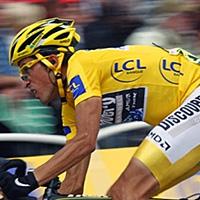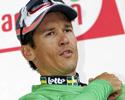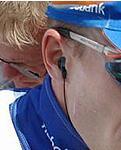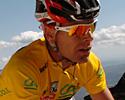
Recently on Cyclingnews.com |
96th Tour de France - GT
France, July 4-26, 2009
Le Tour 101
By the Cyclingnews team
During the Tour we're inundated with questions about the race, often from relative newcomers to cycling who are perplexed by cycling's unique mix of French, Italian, English and velospeak jargon, but sometimes even from old hands who have finally cracked and demand to know what 'combativité' really means. Here's our feature to help, in two sections:
If there's a question you'd like to see answered here, or a term that needs explaining please drop us a line.
Answers to a few Frequently Asked Questions
When will the detailed stage routes, start and finish times and so on, be available?
Tour organiser ASO usually releases detailed stage route information some time in June, but at the time of writing (June 18) ASO has not yet made route details available, nor is information such as stage start times and estimated finish times yet available.
As soon as we have these details, we'll post them on Cyclingnews.
We realise this is very useful information as knowing the locations of the major climbs, sprints and so on allows you to plan a day out watching the race, but for some reason ASO is keeping this information to itself until the very last moment this year.
That said, the Tour is a sufficiently huge event that it dominates anything that's happening in a particular area. If you're planning a trip to a Tour stage town and want to make sure you catch the action, the local tourist office should be able to tell you everything you need to know once you're there.
Why do so many riders have the same finish time? They can't all cross the line together surely?
It's impossible for 180 riders to all cross the line simultaneously, of course, so the Tour (and most other stage races) operates the 'legal fiction' that all the riders in the race's main pack cross the line at the same time as the first rider. However, if a split forms and the gap is larger than one second, the next group gets the time of the first rider of that group. Overall, it's designed to save a mad rush for the line and in most cases it's too difficult to allocate separate times.
What do the jerseys mean?





|
Yellow
The overall leader on general classification (GC). GC is the sum of each day's
finish times, less any time bonuses the rider might earn for a stage win or
place. The yellow jersey of race leader therefore goes to the rider with the
lowest total time for the race.
Green
There are points allocated to the position in each day's finish and the rider
with the largest number of these points wears the green jersey. This jersey
therefore involves a contest between the sprinters - riders who can accelerate
very quickly at the end of a stage to win the final dash across the line. There
are also time bonuses on offer to all riders. In the first week of the Tour
- well, before it hits any serious climbs - the time gaps between all riders
are quite small, making the intermediate sprints and stage finishes hotly contested.
On offer are time bonuses: 6sec - 1st, 4sec - 2nd, 2sec - 3rd for the intermediate
sprints and a 20 second time bonus for the stage winner. Although they're called
'bonuses', the time is actually deducted from their overall time classification
which is why the first week of the Tour can feature sprinters such as Robbie McEwen and Tom Boonen wearing the maillot jaune.

|
Polka dot
The white jersey with red dots, or 'maillot pois' is awarded to the race's best
climber, or to be precise to the winner of a points contest that's conducted
at the top of each of the race's climbs. The higher the category of the climb,
the more points for being the first across the line at the top.
White
Best young rider. 'Young' in the case of the a Grand Tour stage race means under
25, or, to be precise, born after January 1, 1981. In some sports 25-year-old
athletes are making retirement plans, but in cycling, and especially in stage
racing, riders don't develop the necessary stamina to succeed until their mid-to-late
20s. Of course there are exceptions. Eddy Merckx was 24 when he won his first
Tour in 1969.
How is the teams classification calculated?
The teams classification is calculated based on the total time of the first three riders across the line from each team on starting with the prologue and then each individual stage (not the first three riders on general classification from each team). The winner of this classification is the team with the lowest cumulative overall time at the end of 20 stages. If a team is reduced to less than three riders, they are eliminated from the teams competition.
How do you get a negative number of points in the points classification?
A number of readers have commented on a curiosity in the points classification in the fight for the maillot vert (green jersey), where some riders actually have negative points. This arises because the organisers impose penalties for various infractions in a number of ways. The most common is a fine of so many Swiss Francs. A harsher penalty is to deduct time from the rider's GC time, or deduct points from their points tally. If the rider has been particularly naughty, they will be disqualified from the race. Riders can be penalised in a lot of ways, e.g. hanging onto a team car, or taking too many "bottles" from the director sportif; answering the call of nature in front of the public (when you gotta go, you gotta go); causing another rider to crash, or otherwise riding dangerously in the bunch; hitching a ride to the finish in the Tour director, Christian Prudhomme's car; giving spectators the evil eye, and so on.
Why is Robbie McEwen in the green jersey when he is tied on points; what method is used to decide who wears the maillot vert when two riders are tied on points?
When two riders have an equal number of points, the criteria used to decide who should wear the green jersey is the rider with the most number of second places where points have been allocated, then the most number of third places, and so on.
Combativité classification. Why is the combativité classification not mentioned on TV; does it have some jersey?
The rider leading the combativité classification is often mentioned, but more so on the flatter stages that allow for opportunists like Jacky Durand, who was famous for his suicide breaks in the Tour, to show their bravery (or in some cases, stupidity). There is no jersey to mark out the leader of the classification, but instead, the rider wears red rider numbers as opposed to the white numbers worn by the rest of the riders. If the leader of the combativité wore a easily distinctive jersey, he would become a marked man and not be able to escape - hence the subtle use of red patches that show his rider number. The honour of the most aggressive rider is decided on the road each day during stages chaired by a panel elected by the Tour organiser, Christian Prudhomme. The overall winner of the classification is determined by adding the points given by all members of the panel in each of the road stages.
How do riders go to the toilet?
Generally, they pull over to the side of the road, stop, and shed liquid ballast in the usual way. Some time in the first couple of hours of the race, a senior rider (a team leader or team captain) will organise a comfort break and the whole peloton will slow down enough that riders can stop for a break and easily catch up afterwards.
The etiquette is that you don't attack while a large-scale comfort break is in progress, and you certainly don't attack the yellow jersey when he's taking a leak, as we saw in stage 6 2002 when Domo and Rabobank were berated by Armstrong and ONCE for attempting to go after a breakaway while race leader Igor Gonzalez de Galdeano was answering nature's call.
On some days there will be no organised break. If the stage is short, fast or very hot it may simply not be necessary, but on a cold morning at the beginning of a long day's trek across Northern France a mass disposal of that last cup of coffee will almost certainly happen.
If a rider needs to go outside of an organised stop, that's another situation where team-work comes into play. Along with a couple of team-mates, the rider will drop back in the peloton, and move to the side of the road. While his team-mates push him along at the back of the bunch, he'll take a mobile comfort break. It's a skilled operation, and some riders just can't relax enough to, er, let it all hang out this way…
It's considered extremely bad form for photographers and TV to shoot this whole process which is why, as some readers have observed, you never see it on TV or in pictures.
Feeding. What are the rules or etiquette for feed zones/stations? For example, do all the riders hold their position while everyone eats, or is permissible to attack?
Just as with taking a comfort break of the urinal variety, the same level of etiquette applies to a comfort break of the gastronomic kind. It is considered very bad form to attack in a feed zone, and you will normally hear about it further down the road if you're brave enough to try. Once the peloton has collected their musette bags (cloth bags that contain water bottles and various items of food) in the feed zone, the race is back on; there's no requirement to ask the whole peloton if they've finished their meal before attacking. In general, feeding is permitted at any time starting from the 50 km marker up to the distance marker indicating "end of feeding", which is 20 km from the finish.
When was the yellow jersey (maillot jaune) introduced?
1919. Eugene Christophe was the first rider to wear it.
Has anyone worn the maillot jaune from start to finish in the Tour de France?
Yes indeedy. Maurice Garin won all six stages of the first ever Tour de France in 1903. Ottavio Bottechia was the next to hold the coveted golden fleece from start to finish in 1924 - although he shared the yellow jersey with another rider for two stages. Nicolas Frantz and Romain Maes were the next riders to replicate the efforts of Garin and Bottechia in 1928 and 1935 respectively.
Are riders allowed to wear different colours on to their usual team outfits?
Riders are not allowed to wear any other outfit than that of their team, the exemption to this rule is if that rider is the world champion, national champion or ProTour leader, then they are required to wear that particular jersey or, of course if they are leading one of the classifications during the Tour. often you will see that these riders will match the colour of their shorts to that of their jersey, a practice that has become much more common in recent years. In fact one of the first riders to do so was the flamboyant Italian sprinter, Mario Cipollini, when he wore an all yellow outfit during a stage in the Tour, he even went so far as to match the colour of his bike. At the time Cipollini and his team were fined for doing so, but in more recent years, the organisation has turned a blind eye to this practice, as it attracts more attention to the jersey, the rider, the team and of course le Tour.
When a team's uniform includes so much yellow that it looks too similar to the maillot jaune, the yellow jersey, Tour de France organisers ask that the teams come to the race with a different look.. During the team time trial however, this rule does not apply, and the team reverts back to its standard team uniform. In recent years both ONCE and Mercatone Uno were required to change their outfits from yellow to pink.
What do the climb categories mean?
Climbs are graded according to their severity, from fourth to first category, plus the very hardest climbs which are considered 'hors catégorie' or 'beyond category'. The gradings take into account the length and steepness of the climb and the position of the climb in the stage, with the quality of the road surface making up a final, less important factor.
How are the gradients calculated?
A grade of, say, ten percent, simply means that the road ascends ten metres for every 100m it travels horizontally. For those with a mathematical bent, it's a simple tangent ratio. Climb grades are averages for the whole climb, so a straightforward-sounding six percent grade can hide some much steeper pitches that make it a monster.
I know that climbs are categorised Cat 1, 2, 3, etc., but is a "1" more difficult than a "4", or is it the reverse?
The categorisation of climbs is determined by the race organisers, and is based on the steepness of the climb, the position of the climb on the stage, and to a lesser extent, the quality of the road surface. Generally speaking, a climb needs to have an average gradient of around 4-5% and a vertical elevation of at least 100 metres for a climb to be categorised. A hors catégorie (literally meaning 'out of category') climb is the most difficult, with an elevation usually 1,500 metres (5,000 feet) or more above sea level - while a category 3 climb is one of the easiest, with an elevation usually in the range of 300-600 metres (1,000-2,000 feet) above sea level.
Speeds. We hear a lot about "average" speeds for stages or parts of stages; however, for amateur or recreational bike racers the only thing that would provide a comparison, is the speed that these guys are holding at any given point. For example: when USPS is riding tempo on flat-ish roads what speed are they sitting on, roughly; and what speed would the riders in the break be holding? What speeds do the top sprinters reach in a bunch sprint?
Average speeds, even across the same race route, can vary markedly depending on the tactics employed by various teams. Generally speaking, on a flat-ish stage of around 200 kilometres in length, the average speed of the peloton would be in excess of 50 km/h on the flatter sections and around 60 km/h in the final kilometres of the stage. Obviously for a break to stay away, they need to be moving faster than the peloton; and by using time checks from the race organisers as well as information from team directors, the riders in the break know what speed they need to be travelling at to stay away and the riders in the bunch know what speed they need to be moving at to catch the break - which is why it almost seems to happen like clockwork when the peloton bridge the gap to the breakaway group, often with less than 10 km to go.
Climbing speeds are particularly difficult to place an arbitrary figure on due to the huge variation in gradients, relative altitude, temperature, wind velocity and direction, and road surfaces. Again, generally speaking, on a climb like Mont Ventoux with an average gradient of around 7.5 percent, the riders in the "laughing group" would be travelling at around 10 km/h on the steeper sections of the climb due to its severity.
Again, the speeds encountered in bunch sprints vary depending on the type of finish; however the winners in previous stages of the Tour de France have reached speeds in excess of 70 kilometres an hour. Now that's movin'.
How does the directeur sportif communicate with the riders?
 |
By radio. Until recently, the directeur sportif relied on word of mouth, and had to tell riders what to do from the team car, but modern communications means radios are universally used for communication between the DS and the riders. A close look at almost any photo of a rider in the Tour will reveal a radio earpiece taped into place. The radio systems used are two-way, so the DS can relay information from the bunch to riders in a breakaway, and so on. Conversely, riders can communicate with either the directeur sportif or members or their team. A plethora of radio frequencies mean that other teams won't be able to listen in to the dialogue from other teams - unless of course they're riding beside the rider in question!
There are three riders away on their own, why isn't the peloton chasing them?
There may be any number of reasons why the peloton doesn't chase down a breakaway. The first is that nobody has decided to chase it down yet. A few riders will often escape in the early part of a stage, tear up the road for a while, gain some valuable exposure for themselves and their sponsors and get reeled in later in the day when the peloton decides to start taking the race seriously.
Alternatively, it may be that the break is composed of little-regarded riders who are no threat to any of the leaders. If that's the case, it may simply not be worth anyone's while to make the effort to chase.
How do the organizers decide the start order for the prologue and following time trials throughout the race?
The start order for the prologue of any Grand Tour is determined by race management, with last year's winner always riding last. The start order for the following time trials is based on a rider's time on general classification from the stage prior to the time trial, with the riders lowest on the overall classification leaving first.
If a rider was first last year and wears number 1, why doesn't last years second place wear number 2?
The only rider number that indicates the placing of a rider from the previous year's race is the overall winner. There is no particular order for the riders from other teams. This rule applies to the three Grand Tours, the World Cup and generally all other major races on the UCI calendar.
What's the protocol for kissing the podium girls? Sometimes it's left cheek, right cheek... other times, left, right, left... or maybe it's right, left, right. Anyway, what gives?
Generally speaking, the custom for kissing an "acquaintance" in France is on the cheek, three times, starting with the left cheek. In Italy, it's twice, also starting with the left cheek. So in the Giro d'Italia you'll see that most of the Italians will kiss the podium girls twice, and in the Tour de France, most of the French riders will kiss the podium girls three times. But if you win, whatever you do, no kissing on the lips, and definitely no tongue!
How much money does the Tour winner get?
In 2006, the winner took home 450,000 euro (out of a total prize pool of 3,177,200 euro) or rather, he didn't. Because it's impossible to win the Tour de France without the assistance of a team, the winner traditionally divides his winnings among the team. In 2007 whoever wins will have around 450,000 euro to hand out, and a total of over three million euro is up for grabs across all the categories.
There's a lot of prize money at stake in the Tour de France, then, and not simply for the final winner. Money is awarded in individual stages down to 25th place, with the exception of the team time trial, as only 21 teams are in the race. Daily prizes are given to the leader of each jersey competition, and each points or mountain sprint carries its own prizes for the first three across the line. Additional prizes are awarded each day to the most aggressive rider (Prix de la Combativite), as well as special primes throughout the race.
Finally, bonuses aren't just available to those who win. A special prize of 1,500 euro per rider is given to each team that finishes with at least 7 of its 9 riders.
Here's a brief look at how some of the classifications paid in 2006:
Prologue 1st 8,000 euro 2nd 4,000 3rd 2,000 4th 1,200 5th 830 Road Stage/Individual Time Trial 1st 8,000 euro 2nd 4,000 3rd 2,000 4th 1,200 5th 830 Prize for each green jersey sprint or HC mountain climb 1st 800 euro 2nd 450 3rd 300 Daily prize for yellow, green, polka dot, and white jerseys: 305 euro Final Individual Classification 1st 450,000 euro 2nd 200,000 3rd 100,000 4th 70,000 5th 50,000 Final Classification: Green, Polka Dot Jerseys 1st 25,000 euro 2nd 15,000 3rd 10,000 Final Classification: White Jersey 1st 20,000 euro 2nd 15,000 3rd 10,000 One euro is currently worth USD$1.58, UK£0.79, Yen 167, and Au$1.64
Who is the oldest rider ever to win the Tour?
Firmin Lambot was 37 when he won in 1922.
If 2003 was the Centenary Tour, how come you listed it as the 90th?
It's 100 years since the first Tour de France, in 1903, but the race hasn't been run every year since then. The third edition was nearly cancelled because of the organisers' disgust with some of the rule-bending antics of the riders in the 1904 race, but World Wars I and II really put the brakes on, with large amounts of France becoming a battleground in the 1914-18 conflict and the Nazis occupying the country in 1939-45.
WWI caused the cancellation of the four editions from 1915 to 1918. The 1914 race just scraped in - it started the day Arch-Duke Ferdinand was shot in Sarajevo. When the Tour returned in 1919 it was without many of the race's pre-War stars, lost in the bloodiest conflict in European history.
During WWII, the Tour organisers of the time refused to cooperate with a Tour proposed by the collaborationist Vichy government that ran occupied France in WWII. A faux Tour de France - called the Circuit de France - was run, but the real thing didn't return until 1947.
What was Centenaire classification?
This was a special award for the 100th anniversary Tour that commemorated the six stage finishes of the original 1903 event. It was simply calculated by adding up the riders' finish positions in Lyon (Stage 6), Marseille (stage 10), Toulouse (stage 11), Bordeaux (Stage 17) Nantes (stage 19) and Paris (stage 20).
Because wasn't based on points or time, unlike every other Tour classification, but on finish position in these stages, the Centenaire leader was the rider with the lowest score. Riders vying for the Centenaire classification were no doubt grateful that they didn't have to ride the original stage distances to reach these finish towns. The longest stage, the finale into Paris was 471km, and even the shortest, the 268km dash from Toulouse to Bordeaux was longer than the longest stage of the 2003 Tour
